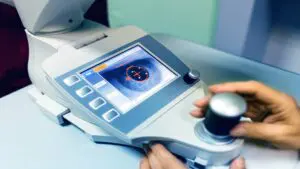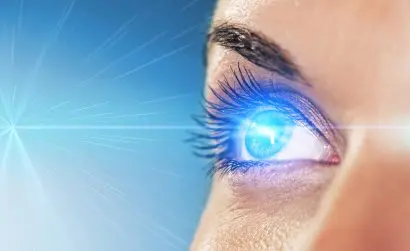If you are considering Lasik surgery, it is important to learn all you can about the different types of procedures that are available. One option that you may not be aware of is topography-guided LASIK. This procedure uses advanced mapping technology to create a custom treatment plan for each individual patient. In this blog post, we will discuss the benefits of topography-guided Lasik and how it can improve your vision!
Contents
What Is Topography Guided Lasik?
 Topography-guided Lasik is an advanced laser vision correction procedure that uses a topography map of your eye to customize your treatment. This map helps your surgeon correct any irregularities in the shape of your cornea, which can improve your vision.
Topography-guided Lasik is an advanced laser vision correction procedure that uses a topography map of your eye to customize your treatment. This map helps your surgeon correct any irregularities in the shape of your cornea, which can improve your vision.
It is an FDA-approved procedure, and it has been shown to be safe and effective. Many people believe that topography-guided Lasik can provide better results than traditional Lasik. The reason might be that it can address more complex corneal irregularities.
Moreover, this surgery is less likely to cause dry eye than traditional Lasik. This is because the surgeon can avoid over-correcting or under-correcting your cornea.
If you are considering laser vision correction, you should talk to your doctor about topography-guided Lasik. It might be the best option for you if you have complex corneal irregularities. And, it can provide you with better vision and fewer side effects.
How Does It Work?
The process of eye surgery is something that has been perfected over centuries. In fact, the first recorded instance of a surgical procedure being performed on the eye is from 200 BC. However, it wasn’t until the late 20th century that Lasik surgery was developed.
The procedure of topography-guided Lasik is very similar to traditional Lasik surgery. First, the surgeon will create a small flap in the cornea. This flap is then lifted so that the excimer laser can be used to reshape the cornea. Once the cornea has been reshaped, the flap is replaced and allowed to heal.
What separates topography-guided Lasik from traditional Lasik is the fact that it uses a topographical map of the eye to guide the laser. This map is created using an instrument called an aberrometer. The aberrometer measures how light is refracted as it passes through the eye. By using this information, the surgeon can create a more accurate map of the cornea. This map is then used to guide the laser during the surgery.
Topography-guided Lasik has a number of benefits over traditional Lasik surgery. Because it is more accurate, it can provide better results. In addition, it is less likely to cause side effects such as dry eye or night vision problems.
If you are considering Lasik surgery, be sure to ask your surgeon if topography-guided Lasik is an option for you. It may just be the best way to improve your vision.
Who Is A Good Candidate For This?
 One of the best things about topography-guided Lasik is that it can be performed on a wide range of patients. Whether you have mild or moderate myopia, hyperopia, or astigmatism, this type of procedure can help improve your vision. In fact, many people who have had traditional Lasik surgery in the past are now turning to topography-guided Lasik to further enhance their vision.
One of the best things about topography-guided Lasik is that it can be performed on a wide range of patients. Whether you have mild or moderate myopia, hyperopia, or astigmatism, this type of procedure can help improve your vision. In fact, many people who have had traditional Lasik surgery in the past are now turning to topography-guided Lasik to further enhance their vision.
If you are considering this type of procedure, the first step is to consult with a qualified eye doctor or surgeon. They will be able to determine if you are a good candidate for the surgery and what type of results you can expect. In general, the criteria for candidacy are:
- Must be at least 18 years old
- Vision must be stable for at least 12 months
- Cannot have any active eye diseases or conditions
- Must not be pregnant or breastfeeding
If you meet all of the above criteria, then you may be a good candidate for topography-guided Lasik surgery. The next step is to schedule a consultation with a qualified surgeon to learn more about the procedure and what you can expect. With the right guidance and surgery, you can achieve excellent vision with topography-guided Lasik.
Benefits Of Topography Guided Lasik
There are many benefits of topography-guided Lasik. Some of the benefits include:
- Greater accuracy- With this type of Lasik, the surgeon can map out the cornea more precisely. This results in greater accuracy and fewer side effects.
- Increased safety- Topography-guided Lasik is a newer technology and therefore has increased safety over traditional Lasik procedures.
- Better vision- Patients who have had this type of Lasik typically have better vision than those who have had traditional Lasik. This is because the surgery is more accurate and there are fewer side effects.
In addition to the benefits above, topography-guided Lasik can also help to improve your vision in low light conditions. This is because the surgery can correct more irregularities in the cornea. If you are considering Lasik, be sure to ask your surgeon if this type of Lasik is an option for you.
If you have any questions, please feel free to contact a professional with experience in this type of Lasik. They will be able to answer any questions that you may have and help you make the best decision for your vision. So do not hesitate to get in touch with someone today.
Risks And Complications
 There might be some risks and complications involved in Topography Guided Lasik treatment. These include:
There might be some risks and complications involved in Topography Guided Lasik treatment. These include:
- Dry eyes: It is one of the most common side effects and usually lasts for a few months. It can be treated with artificial tears.
- Visual aberrations: Some people might experience halos, starbursts, and double vision. These usually go away within a few weeks.
- Under correction or over correction: This means that your vision has not improved as much as you wanted it to. It can be corrected with a second surgery.
- Flap complications: The flap that is created during the surgery can sometimes be dislodged. this can cause serious problems and might require a full corneal transplant.
- Night vision problems It might take some time for your night vision to improve. You might experience glare, halos, and starbursts. These usually go away within a few months.
In addition, there are some general risks that are associated with any type of surgery, such as:
- Infection
- Bleeding
- Inflammation
- Reaction to anesthesia
- Blood clots
There is always a risk of something going wrong during any type of surgery. However, the risks involved in Topography Guided Lasik are low and most people have a successful surgery with no complications.
Therefore, you should talk to your doctor about the risks and benefits of Topography Guided Lasik before you decide if it is right for you.
What You Can Do To Manage The Risks?
There are a number of things you can do to manage the risks associated with topography-guided Lasik:
- Educate yourself about the procedure and what it entails. This includes understanding the risks and benefits, as well as what you can expect during and after the surgery.
- Find a reputable surgeon who has experience performing topography-guided Lasik.
- Make sure you are a good candidate for the surgery. This means having a thorough eye exam and being evaluated by your surgeon to ensure that Lasik is right for you.
- Follow all of your surgeon’s pre-and post-operative instructions. This will help to minimize any risks associated with the surgery.
- Always maintain a healthy lifestyle and regular eye exams. This will help to keep your eyes healthy and reduce the risk of complications from any type of surgery.
If you are considering topography-guided Lasik, be sure to discuss all of the risks and benefits with your surgeon. In addition to these tips, you can try some basic and primary tips, these include:
- Wearing sunglasses: Sunglasses help protect your eyes from the sun’s harmful ultraviolet (UV) rays.
- Washing your hands: Washing your hands helps to prevent the spread of bacteria and viruses.
- Avoid rubbing your eyes: It is important to avoid rubbing your eyes, as this can irritate them and lead to further complications.
When it comes to your vision, you want to make sure that you are taking care of your eyes. Topography-guided Lasik is a great way to improve your vision, but it is important to understand the risks involved. By following these tips, you can help to minimize the risks and ensure that you have a successful surgery.
Conclusion
To conclude, topography-guided Lasik is an enhanced form of Lasik surgery that can correct a variety of vision problems. The procedure is customized to the individual, which makes it much more effective than traditional Lasik surgery. If you are considering Lasik surgery, be sure to ask your doctor if this surgery is right for you.
It could be the best decision you ever make for your vision. So don’t wait, find a top-rated Lasik surgeon in your area, and get started on the road to better vision today!
For more information and guidance, please contact Eye Mantra. EyeMantra offers the most advanced LASIK options including PRK, Femto Lasik, SMILE surgery, Standard lasik, and Contoura vision. If you have any questions on lasik surgery, lasik surgery cost and lasik procedure, call us at +91-9711116605 or email at [email protected].


